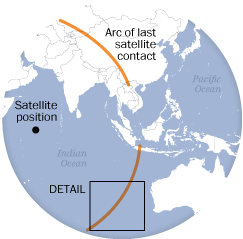 Teams searching for missing Malaysian Airlines flight 370 face a race against time to narrow the search area before the 37.5kHz ‘pings’ from the wreckage of the flight run out of power and stop transmitting. As part of the search effort, the Australian Maritime Safety Authority (AMSA) has been employing the Commonwealth Scientific Industrial Research Organization’s (CSIRO) ocean modeling capabilities to help define the area covered by search and rescue teams.
Teams searching for missing Malaysian Airlines flight 370 face a race against time to narrow the search area before the 37.5kHz ‘pings’ from the wreckage of the flight run out of power and stop transmitting. As part of the search effort, the Australian Maritime Safety Authority (AMSA) has been employing the Commonwealth Scientific Industrial Research Organization’s (CSIRO) ocean modeling capabilities to help define the area covered by search and rescue teams.
A team of oceanographers at CSIRO, led by Dr David Griffin and Dr Andreas Schiller, has been using a number of ocean models to firstly backtrack the items spotted by satellite to a possible crash site, and secondly to forward-track possible debris from the crash. This helps to locate items seen by satellites several days ago, to direct boats and planes to where the items could have drifted.
Australia’s search and rescue service covers 52.8 million square kilometers of the Indian, Pacific and Southern Oceans. According to CSIRO, debris can travel up to 50km a day in the area of the Indian Ocean where the search is being conducted.
One of the techniques employed by CSIRO is to model the flow of ocean currents so that when a piece of debris is located it can be tracked to the original location of the crash site.
Forward tracking allows search teams to locate previously spotted debris by forecasting the likely position based on ocean conditions at the time. This can be crucial to verify if debris actually came from the crash site or another source.
The models use data from the Global Ocean Observing System and Australia’s Integrated Marine Observation System (IMOS). Three satellites (Jason-2, Cryosat-2 and SARAL) are also used in the project. The satellites are equipped with altimeters, which map ocean-surface topography.
CSIRO states that the models are not completely precise, but they are a big help in tracking how debris could move across the ocean over time.
This story appears here as part of a cross-publishing agreement with Scientific Computing World.



